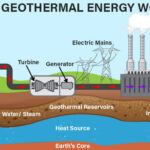In the quest for cleaner, more sustainable energy sources, biomass energy has become an increasingly important part of the global conversation. But what is biomass energy, and how exactly is it generated? This article breaks down the science and significance of bioenergy in an accessible, engaging way—perfect for beginners looking to understand the role of organic material in powering our world.
Understanding Biomass Energy
Definition and Overview
Biomass energy is a type of renewable energy derived from organic materials such as plants, wood, agricultural residues, and even animal waste. These materials, collectively called biomass, store energy from the sun through the process of photosynthesis. When processed or burned, this stored energy is released as heat or electricity.
Common Biomass Sources:
- Wood and wood chips
- Crop residues (e.g., corn stalks, wheat straw)
- Animal manure
- Food and yard waste
- Dedicated energy crops (e.g., switchgrass, miscanthus)
How Is Biomass Energy Generated?
The process of converting biomass into usable energy can vary, but it generally involves chemical, thermal, or biological conversion methods. Below, we explain the main technologies used to generate bioenergy.
1. Combustion (Direct Burning)
This is the most traditional method. Biomass is burned to produce heat, which is then used to boil water. The resulting steam spins a turbine connected to a generator, creating electricity.
Advantages:
- Simple and widely used technology
- Effective for large-scale energy production
2. Gasification
In this process, biomass is heated in a low-oxygen environment to produce syngas (synthetic gas), which consists mainly of carbon monoxide and hydrogen. This gas can then be burned for heat or used to power turbines.
Benefits of Gasification:
- Higher efficiency than direct combustion
- Lower emissions
3. Anaerobic Digestion
Biomass materials such as animal manure and food waste are broken down by bacteria in an oxygen-free environment. This generates biogas, mainly composed of methane and carbon dioxide, which can be used for heating, electricity, or fuel.
4. Pyrolysis
Here, biomass is subjected to very high temperatures in the absence of oxygen, producing bio-oil, syngas, and biochar. Bio-oil can be used as a liquid fuel, while biochar is often applied to improve soil quality.
Types of Biomass Energy Systems
Small-Scale Systems
Used in rural homes and farms, these systems may include wood stoves, pellet boilers, or small anaerobic digesters. They provide local heating and power without relying on the grid.
Large-Scale Power Plants
Industrial-scale biomass plants can generate electricity for thousands of homes. Often, these plants co-fire biomass with coal to reduce emissions while maintaining efficiency.
Environmental Impact and Sustainability
One of the major benefits of biomass energy is that it’s renewable and potentially carbon-neutral—if managed responsibly.
Environmental Benefits:
- Carbon Neutrality: The CO2 released during combustion is offset by the CO2 absorbed during plant growth.
- Waste Reduction: Biomass energy gives value to agricultural, forestry, and food waste that might otherwise be landfilled.
- Soil Enrichment: Biochar produced during pyrolysis can enhance soil health and carbon storage.
Challenges:
- Land Use: Growing energy crops may compete with food production or lead to deforestation.
- Air Pollution: Poorly managed combustion can release particulates and pollutants.
- Efficiency: Not all biomass systems are energy-efficient; some lose much of the original energy during processing.
Global Use and Trends
Biomass energy is used around the world, especially in countries looking to diversify their renewable energy portfolios. In the U.S., bioenergy contributes about 5% of total energy consumption. In the EU, countries like Sweden and Finland rely heavily on biomass to heat homes and power industries.
Emerging Innovations:
- Advanced biorefineries producing renewable diesel and jet fuel
- Genetically modified energy crops for higher yields
- Waste-to-energy plants turning municipal waste into electricity
How Can Individuals Support Biomass Energy?
You may not run a power plant, but there are practical ways to support biomass and reduce your own environmental footprint.
Ways to Get Involved:
- Use biomass-based products: Choose wood pellets or biomass boilers for home heating.
- Compost your food waste: Support anaerobic digestion and nutrient cycling.
- Buy green energy: Many utilities offer plans that include biomass in their renewable mix.
In summary, understanding what biomass energy is and how it is generated opens the door to appreciating a key solution in the clean energy transition. By converting everyday organic materials into useful power, biomass plays a dual role in reducing waste and supplying sustainable energy. Whether through supporting renewable energy policies or composting food scraps, we all have a part to play in shaping a cleaner, greener future.



